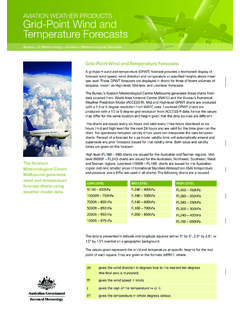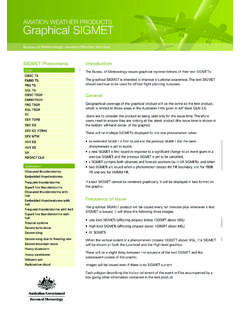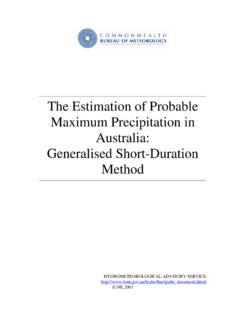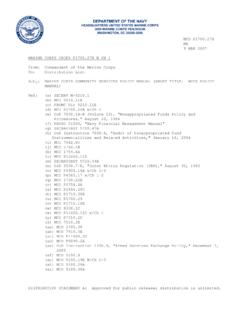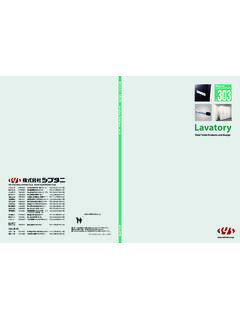Transcription of AVIATION WEATHER PRODUCTS Runway Visual Range …
1 AVIATION WEATHER PRODUCTS . Runway Visual Range Bureau of Meteorology AVIATION WEATHER Services Introduction Runway Visual Range (RVR) provides pilots, air traffic service (ATS) units and other aeronautical users with information on Runway visibility conditions during periods of low visibility. Low visibility is defined by the RVR system as visibilities below 2000m. The most frequent cause of low visibility is due to mist or fog however other common causes include rain, snow, and sandstorms. More specifically, the RVR system assesses whether conditions are above or below a specified operating minima for take-off and landing. In Australia RVR readings from instrumented systems are limited to reduced visibility events due to mist or fog. Data obtained from the RVR system is one parameter used for assessing the availability of instrument approaches for an aerodrome. RVR is an assessment of the Runway Key requirements for RVR Visual Range and it may not be representative of other areas of the aerodrome such as taxiways.
2 RVR systems are available at some major airports in Australia, such as Sydney Background light level; and and Melbourne, and is planned to be installed at other major airports in the future. Intensity of Runway lights. RVR is not an observation' or a measurement' of a meteorological parameter such as surface wind, temperature or pressure. It is an assessment, based on calculations that take into account various elements including atmospheric, physical/biological and In assessing RVR, no operational factors. account is taken of the effect on the pilot's vision of such factors as: Definitions Transmittance of the Visibility windscreen; Visibility for aeronautical purposes is the greater of: Rain on the windscreen; (a) the greatest distance at which a black object of suitable dimensions, situated near the ground, can be seen and recognized when observed against a bright Cockpit lighting;. background, which is represented by the meteorological optical Range (MOR).
3 Pilot exposure to other light sources; (b) the greatest distance at which lights in the vicinity of 1 000 candelas can be seen and identified against an unlit background, which is represented by RVR or Runway Physical or psychological Visibility. state of the pilot;. Note: Given the distances are measured using different measurement techniques the two Directionality of background distances may be different. luminance; and Increase in background Runway Visual Range (RVR). luminance from backscatter Runway Visual Range is the Range over which the pilot of an aircraft on the centre line of aircraft landing lights. of a Runway can see the Runway surface markings or the lights delineating the Runway or identifying its centre line. In Australia RVR is used exclusively in relation to RVR. measured by an instrumented system. View from the cockpit when the aircraft is on the centre of a Runway indicating Runway Visual Range or Runway visibility.
4 Runway Visibility (RV). Note: RVR applies only for the Runway visibility is the distance along a Runway over which a person can see and Visual Range on the Runway . recognise a visibility marker or Runway lights. In Australia the term Runway visibility' is The conditions during approach used by ATC, pilots or ground personnel authorised to report visibility along a Runway may be significantly different. as determined by a ground observer. Until the pilot is actually on the Runway , the view from the Meteorological Optical Range (MOR). cockpit down to the ground Meteorological optical Range is defined as is the greatest distance at which a black represents rather a slant object of suitable dimensions, situated near the ground, can be seen and recognized Visual Range (SVR) and as when observed against a bright background. In Australia MOR is measured by a such may be affected by fog visibility sensor or observed by a qualified meteorological observer.
5 Densities varying with height. View of an airport indicating the prevailing visibility. Slant Visual Range (SVR). The Visual Range of a specified object or light along a line of sight which differs significantly from the horizontal; for example, the Visual Range of ground objects or lights as seen from an aircraft on the approach. Slant Visual Range of the Runway as seen from an aircraft on the approach. Measurement or observing practices There are currently two main observing techniques in use for the assessment of visibility along a Runway ; RVR, the instrument technique and RV, the human observer technique. Instrumented technique Transmissometers are instruments used to measure the light transmittance of the atmosphere. RVR is then calculated taking into account the measured quantity ( transmittance), Runway light levels and the expected detection sensitivity of the pilot's eye under the prevailing conditions of background luminance.
6 Human observer technique The human observer technique to measure Runway visibility relies upon a trained observer at the aerodrome to count the number of Runway lights or markers visible from a specified observing position near the Runway in accordance with CASA Manual of Standards Part 139. This number is converted to a Runway visibility, making due allowance for the differences in light intensity and background luminance from the different viewing positions of the observer and the pilot. Sometimes, where it is difficult to count Runway lights, observations are made on a special row of Runway or Transmissometer at Perth Airport. other lights set up near the Runway . Due to its inherent weaknesses, the human observer method is typically only used Limitations of using RVR under the following circumstances: data (a) at an aerodrome with low frequency of occurrence of fog, or any other WEATHER RVR use has practical phenomena reducing RVR below 1500 m (not recommended for Categories II.)
7 Limitations as follows: (b) for non-precision approach runways; and RVR is a value which typically (c) as a back-up in case of failure of the instrumented system (not recommended for only has meaning for the Categories II and III). portions of the Runway associated with the RVR Instrumented Approach and landing report (TDZ, MID, or END). Category Height Visibility RVR. RVR may vary with Runway I 200ft (60m) 800m 550m light step settings. II 100ft (30m) but < 200ft (60m) Not applicable 300m RVR may not be IIIa < 100ft (30m) or no decision height Not applicable 175m representative of actual ( 0ft). visibility along portions of the IIIb < 50ft (15m) or no decision height Not applicable 50m but < 175m Runway due to the location ( 0ft). of the transmissometer or due to variable WEATHER IIIc No decision height ( 0ft) Not applicable No RVR limits ( 0m). conditions ( patchy fog). Content from ICAO Annex 6 and Annex 14.
8 RVR is an instrumentally derived value that has operationally significant Reporting procedures limitations and can be RVR information is included in METAR/SPECI whenever either the prevailing visibility greater than or less than the or RVR is less than 1 500 m. actual visibility available to a pilot at typical flight deck eye The RVR at a Runway 's threshold in the METAR/SPECI is given by RDD[r]/[n]. height (ground level) at the V1V1V1V1 [V[n]V2V2V2V2][i]. Runway . This is particularly true at night, if Runway lights RVR is reported in steps of: are not at settings standard for the prevailing conditions, (a) 25 metres when the RVR is less than 400 metres;. or if unusual daylight (b) 50 metres when the RVR is 400 metres or more, but less than 800 metres; and conditions are experienced (c) 100 metres when the RVR is 800 metres or more. such as when a Runway is aligned with a sunrise or Any observed value which does not fit the reporting scale is rounded down to the sunset condition, in shallow nearest resolution value.
9 RVR can be assessed from more than one location along the or patchy fog. Runway , , the value representative at touchdown zone (TDZ), mid-point (MID) and roll - out portion (END). However, in METAR/SPECI only the value representative of the touchdown zone is given, and no indication of location on the Runway is included. The RVR is also transmitted to aircraft by ATS units, via data link ( D-ATIS, D-VOLMET) or via aeronautical broadcasts ( ATIS, VOLMET). When the RVR is to be reported and RVR data is unavailable, it will be reported as RDD////. CODE DESCRIPTION. R A fixed indicator, denoting that RVR information follows DD Designator for the Runway for which RVR is being reported r Parallel runways will be distinguished by the letter L, C or R indicating the left, centre or right Runway , respectively. / A fixed separator n will only be reported when the RVR is assessed to be one of the following: greater than 2000 metres, in which case n will be reported as P, and the group will be reported as P2000.
10 Greater than the maximum value which can be assessed by the system, and this maximum value is 2000 metres or less, in which case n will be reported as P, and VVVV will report the maximum value, P1700;. less than 50 metres, in which case n will be reported as M, and the group will be reported as M0050;. less than the minimum value which can be assessed by the system, and this minimum value is 50 metres or more, in which case n will be reported as M, and VVVV will report the minimum value, M0100. Common WEATHER phenomena CODE DESCRIPTION. reducing visibility V1V1V1V1 Gives the last 10-minute average RVR value, except when the RVR has Phenomenon Typical MOR varied significantly during the 10 minutes in which case it gives the values (m) minimum 1-minute average value during this period (and is followed by V[n]V2V2V2V2). Fog 30 1000. V A conditional indicator, included only when RVR has varied significantly Mist 1000 5000.


